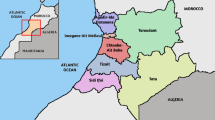Abstract
Consanguineous marriage is a common practice in Iran. The present study surveyed the trend in consanguineous marriage across three generations of Iranians. Index cases, consisting of 400 individuals attending the diabetes and osteoporosis clinic in Shariati Hospital, were interviewed. Data on consanguinity status for 1789 marriages within the index cases’ families were obtained. Generation 1 consisted of marriages contracted before 1948, Generation 2 consisted of marriages contracted between 1949 and 1978, and Generation 3 consisted of marriages contracted after 1979. Prevalence of consanguineous marriage within these three generations was 8.8%, 16.6% and 19%, respectively, and represented a significant trend (p < 0.001). First cousin marriage was the most common type of consanguinity (69%). Socioeconomic level of families was not significantly related to having a consanguineous marriage. These data suggest that premarital genetic counseling and mass media efforts are needed to increase public awareness about genetic risks associated with consanguineous marriage.

Similar content being viewed by others
References
Abbasi-Shavazi, J. M., McDonald, P., & Hosseini-Chavoshi, M. (2008). Modernization or cultural maintenance: the practice of consanguineous marriage in Iran. Journal of Biosocial Science, 18, 1–23. doi:10.1017/S0021932008002782.
Akrami, S. M., & Osati, Z. (2007). Is consanguineous marriage religiously encouraged? Islam and Iranians considerations. Journal of Biosocial Science, 39(2), 313–316. doi:10.1017/S0021932006001684.
Alwan, A., & Modell, B. (1997). Community control of genetic and congenital disorders. EMRO Technical Publication Series 24. WHO Regional Office for the Eastern Mediterranean Region, Egypt.
Arabmazar, H. E. A. (1997). Successfully meeting population goals. Islamic Republic of Iran. Population Headliners, 257, 7.
Bennett, R. L., Motulsky, A. G., Bittles, A., Hudgins, L., Uhrich, S., Lochner Doyle, D., et al. (2002). Genetic counseling and screening of consanguineous couples and their offspring: Recommendations of the national society of genetic counselors. Journal of Genetic Counseling, 11(2), 97–119. doi:10.1023/A:1014593404915.
Bittles, A. H. (1994). The role and significance of consanguinity as a demographic variable. Population and Development Review, 20, 561–584. doi:10.2307/2137601.
Bittles, A. H. (2001). Consanguinity and its relevance to clinical genetics. Clinical Genetics, 60, 89–98. doi:10.1034/j.1399-0004.2001.600201.x.
Christianson, A., Streetly, A., & Darr, A. (2004). Lessons from thalassaemia screening in Iran. British Medical Journal, 329, 1115–1117. doi:10.1136/bmj.329.7475.1115.
Fathzadeh, M., Babaie Bigi, M. A., Bazrgar, M., Yavarian, M., Tabatabaee, H. R., & Akrami, S. M. (2008). Genetic counseling in Southern Iran: Consanguinity and reason for referral. Journal of Genetic Counseling, 17(5).
Hamamy, H., & Jamhawi, L. (2005). Consanguineous marriage in Jordan: Why is the rate changing with time? Clinical Genetics, 67, 511–516. doi:10.1111/j.1399-0004.2005.00426.x.
Hoodfar, E., & Teebi, A. S. (1996). Genetic referrals of Middle-Eastern origin in a western city: Inbreeding and disease profile. Journal of Medical Genetics, 33, 212–215.
Modell, B., & Darr, A. (2002). Genetic counseling and customary consanguineous marriage. Nature Reviews. Genetics, 3, 225–229. doi:10.1038/nrg754.
Muller, R. F., & Young, I. D. (2001). Emery’s elements of medical genetics (11th ed., p. 100). Edinburgh: Churchill Livingston.
Roudi, F. (1997). Surprising decline in Iran’s growth rates. Population Today, 25(11), 4.
Saadat, M., Ansari-Lari, M., & Farhud, D. D. (2004). Consanguineous marriage in Iran. Annals of Human Biology, 31, 263–269. doi:10.1080/03014460310001652211.
Samavat, A., & Modell, B. (2004). Iranian national thalassaemia screening programme. British Medical Journal, 329, 1134–1137. doi:10.1136/bmj.329.7475.1134.
Teebi, A. S., & Farag, T. I. (Eds.). (1997). Genetic disorders among Arab populations (1st ed). New York: Oxford University Press.
Walter, H., Farhud, D. D., Danker-Hopfe, H., & Amirshahi, P. (1991). Investigations on the ethnic variability of the ABO blood group polymorphism in Iran. Zeitschrift fur Morphologie und Anthropologie, 78(3), 289–306.
Acknowledgments
This study was part of the second and third authors’ research theses for their MD degrees. We would like to thank all of the doctors and nurses in the EMRC and Diabetes and Osteoporosis clinics who helped us to conduct this study. Special thanks go to Professor Bernadette Modell and Dr. Pat McCarthy Veach for their critical review of this paper.
Author information
Authors and Affiliations
Corresponding author
Rights and permissions
About this article
Cite this article
Akrami, S.M., Montazeri, V., Shomali, S.R. et al. Is There a Significant Trend in Prevalence of Consanguineous Marriage in Tehran? A Review of Three Generations. J Genet Counsel 18, 82–86 (2009). https://doi.org/10.1007/s10897-008-9191-y
Received:
Accepted:
Published:
Issue Date:
DOI: https://doi.org/10.1007/s10897-008-9191-y




